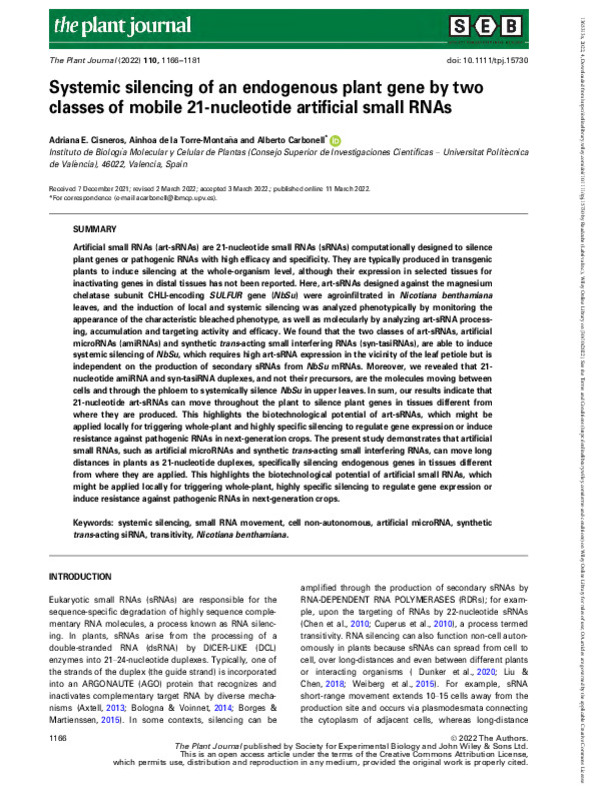|
Resumen:
|
[EN] Artificial small RNAs (art-sRNAs) are 21-nucleotide small RNAs (sRNAs) computationally designed to silence plant genes or pathogenic RNAs with high efficacy and specificity. They are typically produced in transgenic ...[+]
[EN] Artificial small RNAs (art-sRNAs) are 21-nucleotide small RNAs (sRNAs) computationally designed to silence plant genes or pathogenic RNAs with high efficacy and specificity. They are typically produced in transgenic plants to induce silencing at the whole-organism level, although their expression in selected tissues for inactivating genes in distal tissues has not been reported. Here, art-sRNAs designed against the magnesium chelatase subunit CHLI-encoding SULFUR gene (NbSu) were agroinfiltrated in Nicotiana benthamiana leaves, and the induction of local and systemic silencing was analyzed phenotypically by monitoring the appearance of the characteristic bleached phenotype, as well as molecularly by analyzing art-sRNA processing, accumulation and targeting activity and efficacy. We found that the two classes of art-sRNAs, artificial microRNAs (amiRNAs) and synthetic trans-acting small interfering RNAs (syn-tasiRNAs), are able to induce systemic silencing of NbSu, which requires high art-sRNA expression in the vicinity of the leaf petiole but is independent on the production of secondary sRNAs from NbSu mRNAs. Moreover, we revealed that 21-nucleotide amiRNA and syn-tasiRNA duplexes, and not their precursors, are the molecules moving between cells and through the phloem to systemically silence NbSu in upper leaves. In sum, our results indicate that 21-nucleotide art-sRNAs can move throughout the plant to silence plant genes in tissues different from where they are produced. This highlights the biotechnological potential of art-sRNAs, which might be applied locally for triggering whole-plant and highly specific silencing to regulate gene expression or induce resistance against pathogenic RNAs in next-generation crops. The present study demonstrates that artificial small RNAs, such as artificial microRNAs and synthetic trans-acting small interfering RNAs, can move long distances in plants as 21-nucleotide duplexes, specifically silencing endogenous genes in tissues different from where they are applied. This highlights the biotechnological potential of artificial small RNAs, which might be applied locally for triggering whole-plant, highly specific silencing to regulate gene expression or induce resistance against pathogenic RNAs in next-generation crops.
[-]
|
|
Agradecimientos:
|
We would like to thank Javier Forment (IBMCP) for helping with the sRNA sequencing data analysis, as well as the greenhouse staff of IBMCP for the maintenance of plants. DCL4i and RDR6i seeds were kind gifts from Drs Kriton ...[+]
We would like to thank Javier Forment (IBMCP) for helping with the sRNA sequencing data analysis, as well as the greenhouse staff of IBMCP for the maintenance of plants. DCL4i and RDR6i seeds were kind gifts from Drs Kriton Kalantidis and David Baulcombe. This work was supported by grants from Ministerio de Ciencia, Innovacion y Universidades (MCIU, Spain), Agencia Estatal de Investigacion (AEI, Spain) and Fondo Europeo de Desarrollo Regional (FEDER, European Union) (RTI2018-095118-A-100 and RYC-2017-21648 to AC, and PRE2019-088439 to AEC).
[-]
|









